
|
|
Favela Tour |
City of God – Violence – A paradox – “Middle class” favela – Drugs and guns – A civic challenge. (Map this!)
The very name “Rio de Janeiro” conjures up visions of gun-touting hoodlums, cars running red lights for fear of stopping and a population terrorized by the vast disparity between classes.
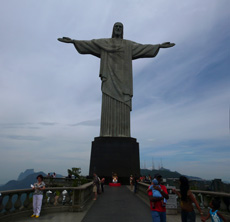
|
|
Corcovado. Click here for panorama. |
This viewpoint is based on travelers’ accounts, who seems to love Brazil inspite of it. The movie “Cidade de Deus” or “City of God” did nothing to dispel this, showing Rio de Janeiro to be a city of murder and mayhem. (I do love the movie). It depicts youngsters with guns, drug lords ruling domains larger than a mid-size city and residents living in a war zone.
This tarred image seems to apply to all of Brazil, so we were fully expecting to be on tenterhooks all the time while visiting, Guatemala style. However, we found the Pantanal and the western states of Brazil to be quite tranquil, with no more precautions required than the normal ones we take with ourselves and the car in any other country.
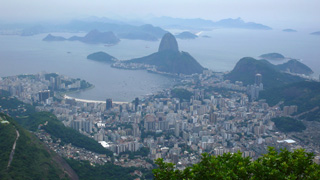
|
|
Sugarloaf |
But back to Rio. The film “Black Orpheus” or “Orfeu Negro” shows another side of Rio and the favelas – the sense of community, a joie-de-vivre and music. Most samba schools are to be found in favelas. Residents of Rio describe the city as a paradox. On one hand, it has breathtaking scenery with islands, cliffs and golden beaches. On the other, swathes of tall, imposing skyscrapers on beautiful, sandy beaches march hand in hand with unpainted brick buildings of the favelas growing higgledy-piggledy on the hillslopes. The superimposition of this contrasting social phenomenon is amazing, from a viewpoint high above the city it is very easy to tell which one is which.

|
|
Favela da Rocinha. Click here for the panorama. |
Out of curiosity and a feeling that favelas are an inseparable part of Rio, we took a favela tour of the biggest favela in Rio, Rocinha, with 60,000-90,000 registered inhabitants. This favela is a “middle class” favela, with doctors offices, regular shops, streetside vendors and middle class tenants in abundance. A big road leads into the favela, and when you first enter the area it looks like any third world country. India, Peru, parts of Mexico – all look like that.
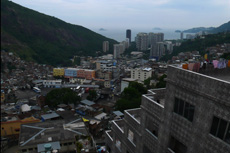
|
|
View from the terrace |
But, on the exhortation of the tour guide, we could not take pictures of people face on. Why? Because they could be drug dealers and thus are breaking the law. Rocinha is governed by the drug gang A.D.A. (Amigos dos Amigos or Friends of Friends), the most violent of the drug gangs in Rio. Elaborate schemes exist for early notification against police entry, including the use of heavily armed men, and even kids whose job is to signal strangers entering a favela. There is only one road through the favela. Access to the rest is through alleyways and stairs in which two people couldn’t fit across. Houses are constructed by paying the local “administration”, which means hardly any construction rules are obeyed – I shudder to think what would happen in case of fire as there were no fire escapes in evidence.
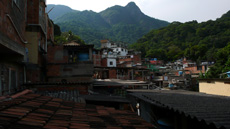
|
|
Villa Canoas |
Rio is indeed a paradox, and a showcase of the challenge of successfully integrating people with varied economic status into a vibrant and safe city. The population in Brazil seems very well integrated in terms of race but very segregated in terms of economic situations. The rich live in beachside residences in gated communities and the favelas intertwine amongst these, where people serving the needs of the rich live – waiters and gardeners, drivers and cooks, construction workers and painters. I haven’t seen any city that has gracefully and successfully integrated this diverse economic spectrum, and Rio is a stark reminder of this challenge.
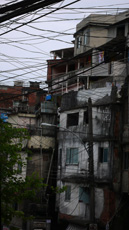 |
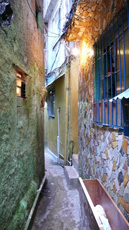 |
 |
|
Wires |
Alley |
School |
They actually give tours of the favelas?
Hi Fred,
Yes they do! I think Favela Tours was the first company to do so, now there’s Jeep tours and various others. Its quite interesting, they monitor the situation to make sure that there’s no current gang wars going on, and that there’s no police action going on either. Favela da Rocinha is not the most dangerous, and Villa Canoas is almost like the Nob Hill of the Favelas.
Apparently Favela da Rocinha had a gang war between “Comando Vermelho” and the “ADA”, when tours were shut down for 45 days. The favela itself was “shut off” for 30 days! ADA won that time and now another war is said to be brewing. So cheap real estate comes at a price!
I appreciate your post. I know exactly what you are talking about and am still struck by the living situation among the rich and poor in the city. I lived in Rio for about 2 months part of the time in Barra de Tijuca which was right near Rocinha and then part of the time in Botafogo. I had wanted to go into the favela but still wasn’t sure about the whole thing. I’ve been reading more and doing research since I’ve returned and it seems that a lot of people say that the foot tours are actually safer and most respected among the community.
I visited Brasil in 2001 and visited a few favelas. The one behind Copacobana had a bar up the hill with spectacular views over the beach and ocean. In another, I was walking with a friend, and it was a festival day – the men were standing in groups drinking beer, the women also in groups gossiping, the girls were singing and dancing to a radio and the boys were playing scissors, paper, rock.
It was the most normal and pleasant place, just like 99% of places throughout the world. At no time did I ever feel nervous or threatened by anyone. The cariocas were the most amazing and friendly people and their love of live is fantastic. OK, there are bad people everywhere – I just didnt come across any in Rio.
How changeable a city image can be! The first words you are using to describe Rio are “gun – totting hoodlums and terrorized population”. Yet I remember vividly that when I was growing up, the name Rio was equivalent with a vision of exotic, sensual beauty, an easy life style, somehow unaffected by turmoil of the world. At the same time, New York City and Chicago were to be avoided, as one could be robbed or shot at any time. Some of that is an urban legend, undoubtedly propagated by Hollywood productions. Yet, there are deeper roots to those popular beliefs. The ever-changing world.
How did you get to Rio given the Ethanol gas problem?
Hi Jaimie,
I think the foot tours are totally safe. Our guide actually told us that favelas were safe, the only issue happens if you get caught in cross fire between gangs and the police.
There are actually hotels and “B&B”s run in favelas too, and of course, samba schools. The residents have a reason for keeping them safe! Not knowing Rio well enough, I would tend to avoid going alone, or rely on a the advice of a Rio resident.
Hi Jerzy,
Shreesh said Rio reminded him of New York as it used to be! Of course, the beaches, beauty and energy are still there…that lends to the city’s paradox! (I do not think life is easy however; food, transport and rent here are very expensive compared to the average salary).
There’s definitely a tension here, the expectation of violence. A lot of Rio residents caution tourists about wandering about Rio alone or even in twos at night. Our B&B owner, an artist who lives in Santa Teresa, talks wishfully about being in a safer atmosphere, leaving Rio.
But we loved this city. We may not be able to live here permanently because of the safety issue, but it is definitely THE most interesting city we have visited on this trip.
Hi Fred,
At this moment we are traveling by bus and our car is safely parked at our friend’s mother’s residence in Panambi. It contains Argentinian gas.
By the way, some people staying in this B&B were renting a car; theirs was stolen off the street in front of the hotel.
It is under-reported, but these gangs are extremely violent, and Rio has a murder rate of countries at war, but these numbers are doctored because these gangs disappear as the dead and missing since the body does not equal dead body. They are sixty thousand missing every year in Brazil, they are heavily armed and heavily armed, its origin dating back to the Cold War as the Commando Vermelho (Red Command) originated from the Falange Vermelha (Red Phalanx) and was founded by political prisoners and common criminals in jail. For sixty years on average because people disappear ml of drug trafficking if we consider that death, because deaths are obviously gives it a death rate higher than the Iraq War. But the government is pacifying these areas with the use of armored vehicles to the army, given the big guns they have and the advantage they have to know the territory. The war between the Rocinha and Friends of Friends Fermelho Command was bloody and had dozens of deaths if not more. Watch: 400 contra 1, to see how the Commando Vermelho (Red Command) has emerged and Ross Kemp on Gangs, Rio, has a part that you see the weapons they use.